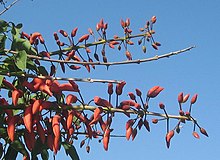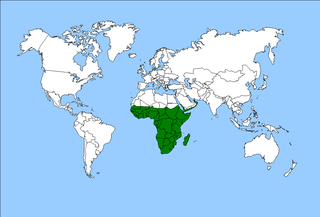
The Afrotropical realm is one of Earth's eight biogeographic realms. It includes Sub-Saharan Africa, the southern Arabian Peninsula, the island of Madagascar, and the islands of the western Indian Ocean. It was formerly known as the Ethiopian Zone or Ethiopian Region.

Tropical and subtropical moist broadleaf forests (TSMF), also known as tropical moist forest, is a subtropical and tropical forest habitat type defined by the World Wide Fund for Nature.

Erythrina is a genus of plants in the pea family, Fabaceae. It contains about 130 species, which are distributed in tropical and subtropical regions worldwide. They are trees, with the larger species growing up to 30 m (98 ft) in height. The generic name is derived from the Greek word ερυθρóς erythros, meaning "red", referring to the flower color of certain species.

The Atlantic Forest is a South American forest that extends along the Atlantic coast of Brazil from Rio Grande do Norte state in the northeast to Rio Grande do Sul state in the south and inland as far as Paraguay and the Misiones Province of Argentina, where the region is known as Selva Misionera.
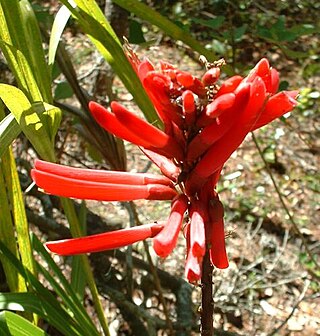
Erythrina herbacea, commonly known as the coral bean, Cherokee bean, Mamou plant in South Louisiana, red cardinal or cardinal spear, is a flowering shrub or small tree found throughout the southeastern United States and northeastern Mexico; it has also been reported from parts of Central America and, as an introduced species, from Pakistan. Various other systematic names have been used for this plant in the past, including Erythrina arborea, Erythrina hederifolia, Erythrina humilis, Erythrina rubicunda, Corallodendron herbaceum and Xyphanthus hederifolius.

Erythrina crista-galli, also known as the cockspur coral tree or ceibo, is a species of flowering tree in the family Fabaceae, native to Argentina, Uruguay, southern Brazil and Paraguay. It is widely planted as a street or garden tree in other countries, notably in California. Its specific epithet crista-galli means "cock's comb" in Latin.

Erythrina mulungu (Mulungu) is a Brazilian ornamental tree and medicinal plant native to the cerrado and caatinga ecoregions in Brazil, South America.
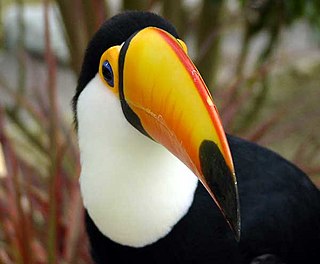
The wildlife of Brazil comprises all naturally occurring animals, plants, and fungi in the South American country. Home to 60% of the Amazon Rainforest, which accounts for approximately one-tenth of all species in the world, Brazil is considered to have the greatest biodiversity of any country on the planet. It has the most known species of plants (60,000), freshwater fish (3,000), amphibians (1,188), snakes (430), insects (90,000) and mammals (775) It also ranks third on the list of countries with the most bird species (1,971) and the third with the most reptile species (848). The number of fungal species is unknown. Approximately two-thirds of all species worldwide are found in tropical areas, often coinciding with developing countries such as Brazil. Brazil is second only to Indonesia as the country with the most endemic species.
Astronium fraxinifolium is a timber tree, which is native to Amazon Rainforest, Atlantic Forest, Caatinga, and Cerrado vegetation in Brazil. Common names include kingwood, locustwood, tigerwood, and zebrawood. It is known in Portuguese as Gonçalo-alves. This plant is cited in Flora Brasiliensis by Carl Friedrich Philipp von Martius. It is also used to make hardwood such as tigerwood.

Aspidosperma cylindrocarpon is a timber tree native to Brazil, Paraguay, Bolivia, and Peru. It is common in Atlantic Forest, Cerrado and Pantanal vegetation of Brazil. This plant is cited in Flora Brasiliensis by Carl Friedrich Philipp von Martius. In addition, it is useful for beekeeping.

Aspidosperma parvifolium is a timber tree native to Brazil, which is typical of Atlantic Forest, Cerrado, Caatinga, and Pantanal vegetation. This plant is cited in Flora Brasiliensis by Carl Friedrich Philipp von Martius. In addition, it is useful for beekeeping.
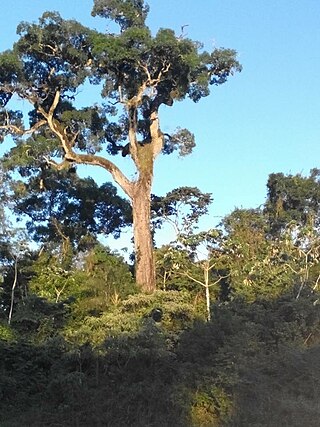
Aspidosperma polyneuron is a timber tree native to Brazil, Colombia, Peru, Argentina, and Paraguay. It is common in Atlantic Forest vegetation. In addition, it is useful for beekeeping.

Anadenanthera peregrina var. falcata is a timber tree native to Paraguay and Cerrado vegetation in Brazil, specially in Mato Grosso, Mato Grosso do Sul, Minas Gerais, and São Paulo. This plant is also used as an ornamental.

Restingas are a distinct type of coastal tropical and subtropical moist broadleaf forest in eastern Brazil. They form on sandy, acidic, and nutrient-poor soils, and are characterized by medium-sized trees and shrubs adapted to the drier and nutrient-poor conditions. One of the most notable restingas is the Restinga da Marambaia, which is owned and kept by the Brazilian Army.
Alchornea triplinervia is a commercial timber tree native to Amazon Rainforest, Atlantic Forest, and Cerrado vegetation in Brazil. This plant is found in the following states of Brazil: Amazonas, Bahia, Espírito Santo, Goiás, Mato Grosso, Mato Grosso do Sul, Minas Gerais, Paraná, Rio de Janeiro, Rio Grande do Sul, Rondônia, Roraima, Santa Catarina, and São Paulo. It is also used as a honey plant.
Erythrina schliebenii is a species of legume in the family Fabaceae. It is found only in Tanzania. The species is named for German collector and botanist Hans-Joachim Schlieben.

The "Pernambuco" interior forests is an ecoregion of the Tropical and subtropical moist broadleaf forests Biome, and the South American Atlantic Forest biome. It lies in eastern Brazil between the coastal Pernambuco coastal forests and the dry Caatinga shrublands of Brazil's interior.

Caatinga is a type of semi-arid tropical vegetation, and an ecoregion characterized by this vegetation in interior northeastern Brazil. The name "Caatinga" is a Tupi word meaning "white forest" or "white vegetation" . The Caatinga is a xeric shrubland and thorn forest, which consists primarily of small, thorny trees that shed their leaves seasonally. Cacti, thick-stemmed plants, thorny brush, and arid-adapted grasses make up the ground layer. Most vegetation experiences a brief burst of activity during the three-month long rainy season.

Falcataria falcata, commonly known as the Moluccan albizia, is a species of fast-growing tree in the family Fabaceae. It is native to the Maluku Islands, New Guinea, the Bismarck Archipelago, and the Solomon Islands. It is cultivated for timber throughout South Asian and Southeast Asian countries. This tree is considered to be invasive in Hawaii, American Samoa and several other island nations in the Pacific and Indian Oceans. It reaches about 30 m (100 ft) tall in nature, and has a massive trunk and an open crown.
